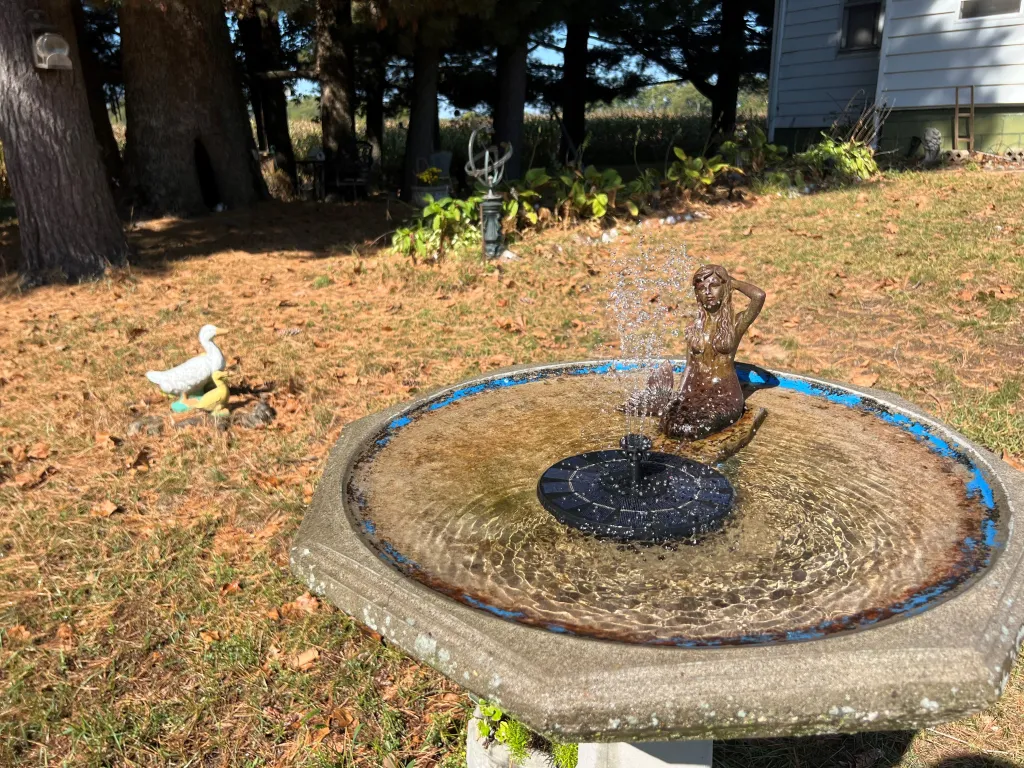
Throughout the summer, I’ve shared more than a few bird bath photos and videos of frolicking feathered friends, and even a few images of my parents’ 20-pound indoor Maine coon cat Tracker V watchful of the splashy proceedings.
Sept. 22 marked the official arrival of Autumn 2025, and now readers’ minds and attention are focused on fall care and maintenance for their favorite yard focal points, such as bird baths and bird feeders.
Reader Belinda Potoma of Michigan City chatted with me last week about bird bath questions and needed seasonal attention.
“I’ve purchased some of your dad’s custom-made birdhouses throughout the years, including a cute design that looks like a tin mailbox,” Potoma noted.
“And I want you to know the birdhouses have had seasonal occupancy too. As for bird baths, we have a traditional concrete one that has lasted over the years but now, unfortunately, is crumbling. Our smaller glass suspended water dish for birds seems to get less traffic.”
Location is key for yard bird baths, usually a sunny and generously spaced lawn landscape is ideal, and of course, it should be centralized within clear viewing distance of a porch, patio or your large window for spectators gazing from inside the house.
Birds will do most of their splashing, bathing and sipping of H2O during the early to mid-morning hours. It is important to keep the bath clear of leaves and debris to keep algae growth at a minimum, which only escalates in these direct sunlight locations. It is also key to scrub and rinse away any deposits, feathers, and seed residue birds might also be guilty of leaving behind.
For our farm bird baths, we have three traditional concrete pedestal designs, including the one in the side yard of my oldest brother Tom’s farm at the end of our road. These baths, long assigned to their same location for decades, attract cardinals, blue jays, wrens, orioles, sparrows, doves and yellow finches, among other flying friends. Observe a bird bath long enough and you’ll discover deer, raccoons, barn cats, dogs, as well as butterflies, wasps, ants and other assorted insects are fond of fresh, cool, clean water repositories.
Even though we’ve entered the autumn phase, with shorter days and cooler nights, it’s still important to keep bird baths clean and in full circulation.
Another reader asked me about an ages-old tradition of painting the inside “bowl” of bird baths a bright blue color to symbolize water available and draw more birds to notice, especially those that might be flying overhead. My dad and aunts were big on this painted bird bath approach, but it’s not very effective, nor recommended. Eventually, paint fades and peels, and the result is the chipped paint gets into the water and on the ground when the bath is cleaned.
You can be assured that the presence of fresh water in a bird bath is easily spotted by birds and other thirsty animals because of the shine from the reflective surface.
During the past two summers, we’ve added a small, inexpensive, floating, solar-powered fountain (less than $20 investment) to help aerate the water, draw more attention and assist with water circulation, which helps keep algae levels lower. Even these fountains have improved over time, from 2.5 watts of power now kicked up to 4 watts of available power. Even on a cloudy day, the newer models will continue to gurgle and spurt.
Since today’s column is “for the birds” and devoted to such a “seed subject” for our globe’s winged wonders, it’s only appropriate I provide a salute to chia seeds paired with a delicious recipe as the weekly menu highlight.
While traveling with my sister Pam and our older brother David in September 2020 to Hilton Head Island, I noticed my siblings like to start their day with a blended fruit “smoothie” which included chia seeds as prime ingredients.
My only familiarity with chia seeds is that they are fast-growing tiny black dots and rose to prominence in the 1970s and 1980s after inventor Joseph Pedott created the first clay and terra cotta molds of rams, cats and dogs, with importer Walter Houston christening the brand as Chia Pets in 1977 and gaining household notoriety by 1982 with the brand’s TV commercial jingle.
Turns out chia seeds have a flavor and health benefits that can also “grow on you.”
According to Harvard Medical studies, chia seeds, which are derived from the Salvia hispanica plant, are a member of the mint family native to Central America, have been a part of human diets for more than 5,000 years and were a staple food for the Aztecs and Mayans.
Harvard Medical research has found a diet of chia seeds as an added ingredient to recipes helps reduce blood pressure, lower cholesterol levels, support digestive health, aid in weight management, reduce inflammation, help control diabetes, protect against chronic disease and reduce bouts of anxiety and depression.
Doctors have found when chia seeds are ingested, they form a gel-like substance in the stomach that increases the feeling of fullness to decrease appetite and calorie intake. The same studies found: “Chia seeds contain a variety of nutrients including fiber, protein, omega-3 fatty acids, antioxidants, and various vitamins and minerals like calcium, magnesium, and phosphorus that are beneficial to your health.”
Columnist Philip Potempa has published four cookbooks and is a radio host on WJOB 1230 AM. He can be reached at PhilPotempa@gmail.com or mail your questions: From the Farm, PO Box 68, San Pierre, Ind. 46374.
Pam’s Chia Seed Fruit Smoothie
Makes 3 cups
1/2 cup of plain Greek yogurt (fruit or vanilla variety can also be used)
1/2 cup of milk (skim, 1%, almond, oat, coconut, your preference)
3 teaspoons of chia seeds, divided use
1/4 cup of walnuts
1/2 cup unthawed frozen fruit of choice (blueberries, strawberries, bananas, blackberries, raspberries)
1 tablespoon of quick oats
Pinch of cinnamon (optional)
1 scant teaspoon vanilla (optional)
1 scoop of protein powder (optional)
1 tablespoon lemon juice
Ice can be added to make the drink thicker, colder
Directions:
1. Mix 1 teaspoon chia seeds to 4 parts water and allow mixture to sit for 10-15 minutes to absorb the liquid.
3. Place all items in a blender.
4. Blend until smooth, approximately 20-30 seconds until all ingredients are combined and the smoothie reaches a desired consistency.
5. Pour into a chilled glass.



